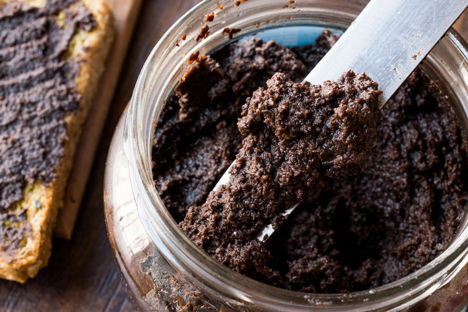
Tapenade: how and when to use it
This deceptively simple olive and caper paste relies on top quality ingredients for its signature hit of deep, savoury flavour. We take a look at the history behind this Provençal classic and find out what makes a really good tapenade.
Tapenade: how and when to use it
This deceptively simple olive and caper paste relies on top quality ingredients for its signature hit of deep, savoury flavour. We take a look at the history behind this Provençal classic and find out what makes a really good tapenade.
When we think of tapenade, it’s hard not to think of crusty baguettes, stubby beers in the sun and holidays in the French Riviera. Visit the south of France and you’ll find tapenade available practically everywhere, either from little tubs in mini markets, stuffed inside roast chicken, spread over the aforementioned crusty baguette or surrounded by fresh crudités.
This black olive paste is synonymous with Provençal cuisine. The name itself actually comes from the Provençal word for capers (tapenas), another crucial element of the simple spread. At its core, tapenade simply combines these two ingredients with some olive oil to make a paste, although you’ll often find other ingredients added – garlic is a common addition (we’re still in France remember), as are sun-dried tomatoes, tuna, anchovy, brandy and herbs like parsley and thyme.
Though tapenade is as Provençal as pastis and boules, it probably doesn’t originate on the French Riviera. We already know that olives were a vital staple in ancient times – the Romans and Greeks virtually lived off olives and olive oil and even before then the Phoenicians were busy planting olive groves in distant parts of the Adriatic. There are multiple accounts of olive pastes in Roman cookbooks dating back to the first century AD, often made with anchovies and vinegar. Even today, olive paste remains an extremely common snack in Greece and Italy – in Crete, the locals mix black kalamata olives with spices, herbs and thyme honey to make a similar spread.
Capers are also native to the Mediterranean, but they too probably started their journey in Greece. Modern day Marseille was originally founded by Greek colonists who travelled from Phocaea, and they brought capers with them on the long journey submerged in amphorae of olive oil. Remember that Provençal word tapenas? Those capers would preserve into a thick caper mush over time that the locals called tapeno – the original tapenade, if you like. We may think of tapenade as French, but this is a condiment with thousands of years of history and roots all over the Mediterranean.
Still, our association of tapenade with the south of France isn’t just down to origin; it’s also because tapenade really sums up what is great about Provençal food. The simple combination of black olives, capers and olive oil gives you a hit of salt from the olives; bitter, grassy undertones from the olive oil and sharpness from the capers. It’s a deceptively easy thing to put together, but it relies almost entirely on really great ingredients, and that in itself is the essence of food in Provence. The olives might come from Morocco; the capers from Sicily and the olive oil from Spain – as long as the ingredients are of the very best quality, it doesn't matter where they come from.
So, how best to eat this delicious condiment? We typically think of tapenade as something to eat with bread or crudités (much like hummus or bagna cauda), but it’s actually incredibly versatile. It makes a fantastic garnish for meat and fish, pairing particularly well with lamb, but it’s equally delicious alongside chicken and meaty white fish like cod and monkfish.
Another smart Provençal trick is to stuff tapenade under your chicken skin before you roast it – this really infuses the flavour into the chicken and gives you lovely moist meat as a result. Equally, you could spread tapenade over the top of a lamb rack before cooking in the oven, not only boosting the flavour of your lamb but also giving you a slightly crispy olive crumb on top.
It also makes a great accompaniment in vegetarian dishes, adding depth and complexity to tried and tested flavour combinations (just take a look at these tomato and tapenade canapés or this vegan tapenade and squash stuffing). You can use tapenade in myriad ways, alongside a huge variety of flavours, but sometimes the simplest ways are still the best – nothing quite beats a dollop of tapenade and a crusty baguette.

